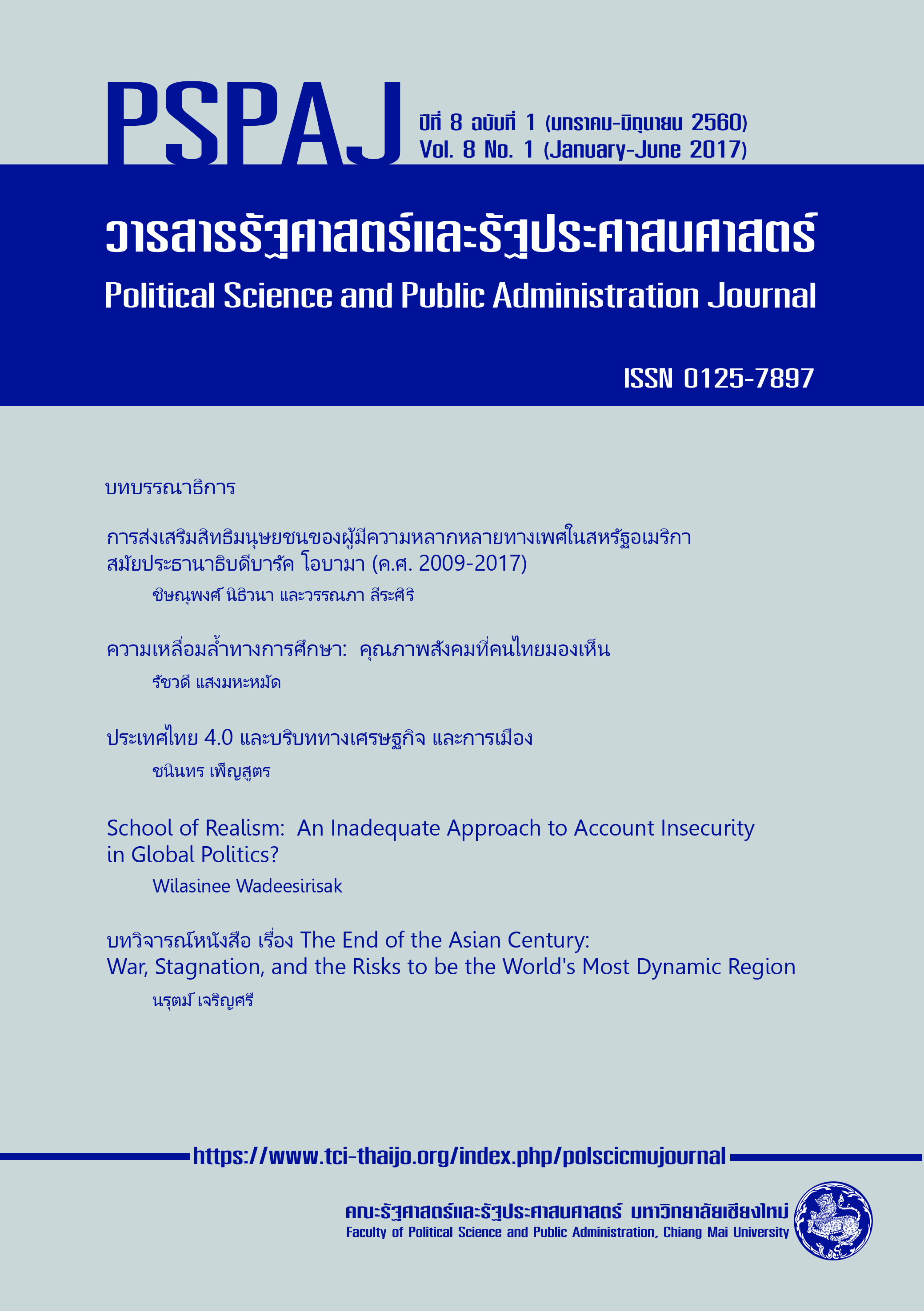Disparities in Education: Social Quality in Thai’s Views
Main Article Content
Abstract
Social disparity is an issue that has been prolonged and may lead to social conflict, weak economic development, and poor quality of life. In this paper, it focuses on the disparity in education, since education is fundamental to developing people. However, equal access to education is an important problem. This study aims to know the public opinion on the disparities in several dimensions and to understand the factors that influence disparities in education in Thailand by using the results from the Citizen Survey on Life and Society, which was conducted by King Prajadhipok’s Institute during October 2014 to March 2015. Descriptive statistics are used to describe the frequency, mean, and standard variation of the basic features. Second, a Chi-square test is used to determine whether there is a significant difference between the economic variables and the dipartites in education. Finally, it uses the regression analysis to analyze the factors affecting people’s opportunities to access education. The results show that income and property is the most inequality in the society. The issues that lead to discrimination include the disability and the education level. Besides, it shows that the factors affecting people’s opportunities to access education are that the discrimination within the society; the inequality of income and property; the dissatisfaction with education; gender; age and location. Therefore, the social policy that is appropriate for Thailand should be the strengthening of socio-economic security, improve the quality of education and meet the labor market needs. Finally, the government should provide more opportunities to people in order to access their rights equally.
Article Details
- เนื้อหาและข้อมูลที่ลงตีพิมพ์ในวารสารรัฐศาสตร์และรัฐประศาสนศาสตร์ถือเป็นข้อคิดเห็นและความรับผิดชอบของผู้เขียนบทความโดยตรง ซึ่งกองบรรณาธิการวารสารรัฐศาสตร์และรัฐประศาสนศาสตร์ ไม่จำเป็นต้องเห็นด้วย หรือร่วมรับผิดชอบใดๆ
- บทความและข้อมูล ที่ได้รับการตีพิมพ์ในวารสารรัฐศาสตร์และรัฐประศาสนศาสตร์ ถือเป็นลิขสิทธิ์ของวารสาร หากบุคคลหรือหน่วยงานใดต้องการนำข้อมูลไปใช้ประโยชน์ในทางวิชาการ ขอให้อ้างอิงแหล่งที่มาด้วย
References
กระทรวงศึกษาธิการ. (2559). สรุปผลการวิจัย PISA 2015. ค้นเมื่อ 10 กุมภาพันธ์ 2560, จาก https://goo.gl/oKzufQ.
โกวิทย์ กังสนันท์. (2559). การคุ้มครองสิทธิมนุษยชนและการลดความเหลื่อมล้ำ. ในการประชุมวิพากษ์ยุทธศาสตร์การวิจัยรายประเด็น. สำนักงานคณะกรรมการวิจัยแห่งชาติ.
ไกรยส ภัทราวาท. (2559). บทเรียนสำคัญจากระดับนานาชาติ 21 ธันวาคม 2016. ค้นเมื่อ 10 กุมภาพันธ์ 2560, จาก https://thaipublica.org/2016/12/kraiyos-pisa-2015/.
ถวิลวดี บุรีกุล และ รัชวดี แสงมหะหมัด. (2560). การสำรวจค่านิยมของประชาชนต่อการเมืองการปกครองและวัฒนธรรมทางสังคมไทย. กรุงเทพฯ: สถาบันพระปกเกล้า.
ธนาคารแห่งประเทศไทย. (2558). รายงานนโยบายการเงิน ธันวาคม 2558. ค้นเมื่อ 9 มกราคม 2560, จาก https://www.bot.or.th/Thai/MonetaryPolicy/MonetPolicyComittee/MPR/DocLib/MPR_December2558_GTH58.pdf.
ธัญลักษณ์ สัมพันธ์. (2556). ความเหลื่อมล้ำด้านสิทธิและโอกาส, สิทธิและโอกาสในการรับบริการสาธารณะ: การศึกษา. ค้นเมื่อ 9 มกราคม 2560, จาก https://sd-group1.blogspot.com/2013/01/ 5324202 5.html.
นณริฏ พิศลยบุตร. (2559). ความเหลื่อมล้ำทางการศึกษาของไทย: ข้อสรุปจากผลการสอบปิซ่า (PISA). จาก https://www.pier.or.th/?post_type=abridged&p=2647.
ประเวศ วะสี. (2544). นโยบายเพื่อคนจน: ล้างโครงสร้าง 10 ประการที่ประหารคนจน. กรุงเทพฯ: จุฬาลงกรณ์มหาวิทยาลัย. อ้างถึงใน สฤณี อาชวานันทกุล. (2554). ความเหลื่อมล้ำฉบับพกพา: แนวคิดหลักว่าด้วยความเหลื่อมล้ำ. (พิมพ์ครั้งที่ 1). นนทบุรี: เป็นไท พับบลิชชิ่ง.
รัฐธรรมนูญแห่งราชอาณาจักรไทย พุทธศักราช 2560.
ราชกิจจานุเบกษา. (2559). ให้จัดการศึกษาขั้นพื้นฐาน 15 ปี โดยไม่เก็บค่าใช้จ่าย (คำสั่งหัวหน้าคณะรักษาความสงบแห่งชาติ ที่ 28/2559). ค้นเมื่อ 9 มกราคม 2560, จาก https://www.ratchakitcha.soc.go.th/DATA/PDF/2559/E/136/11.PDF.
ศูนย์บริการวิชาการเศรษฐศาสตร์. (2559). ตัวชี้วัดของเป้าหมายการพัฒนาที่ยั่งยืน. โครงการประสานงานการวิจัยเพื่อสนับสนุนการพัฒนาที่ยั่งยืน (SDGs). มหาวิทยาลัยธรรมศาสตร์, คณะเศรษฐศาสตร์. จาก https://sdgmove.com/.
สถาบันพระปกเกล้า. (2553). คุณภาพสังคมเพื่อคุณภาพประเทศไทย. กรุงเทพฯ: จรัลสนิทวงศ์การพิมพ์.
______. (2559). รายงานผลการสำรวจความคิดเห็นของประชาชนเกี่ยวกับความพึงพอใจต่อการบริการสาธารณะ และการทำงานของหน่วยงานต่างๆ พ.ศ. 2559 และสรุปผลการสำรวจ พ.ศ. 2546-2559. (ระหว่างดำเนินการจัดพิมพ์)
สมชัย จิตสุชน และ จิราภรณ์ แผลงประพันธ์. (2556). รายงานฉบับสมบูรณ์โครงการศึกษาประเด็นเชิงนโยบายด้านความยากจนและการกระจายรายได้. สถาบันวิจัยเพื่อการพัฒนาประเทศไทย. นำเสนอ สำนักงานคณะกรรมการพัฒนาการเศรษฐกิจและสังคมแห่งชาติ.
สฤณี อาชวานันทกุล. (2554). ความเหลื่อมล้ำฉบับพกพา: แนวคิดหลักว่าด้วยความเหลื่อมล้ำ. (พิมพ์ครั้งที่ 1). นนทบุรี: เป็นไท พับบลิชชิ่ง.
สำนักงบประมาณ. (2559). งบประมาณโดยสังเขป. ฉบับปรับปรุงตามพระราชบัญญัติงบประมาณรายจ่าย ประจำปีงบประมาณ พ.ศ.2559. สำนักนายกรัฐมนตรี, สำนักงบประมาณ. จาก https://www.bb.go.th/budget_book/e-Book
2559/FILEROOM/CABILIBRARY59/DRAWER01/GENERAL/DATA0000/00000572.pdf.
สำนักงานคณะกรรมการการศึกษาแห่งชาติ. (2542). พระราชบัญญัติการศึกษาแห่งชาติ พ.ศ. 2542. กรุงเทพฯ: สำนักงานคณะกรรมการการศึกษาแห่งชาติ.
สำนักงานคณะกรรมการพัฒนาการเศรษฐกิจและสังคมแห่งขาติ. (2559). รายงานการวิเคราะห์สถานการณ์ความยากจนและความเหลื่อมล้ำในประเทศไทย ปี 2558. กรุงเทพฯ: สำนักงานคณะกรรมการพัฒนาการเศรษฐกิจและสังคมแห่งขาติ, สำนักพัฒนาฐานข้อมูลและตัวชี้วัดภาวะสังคม.
______. (2559). แผนพัฒนาเศรษฐกิจและสังคมแห่งชาติ ฉบับที่ 12 (พ.ศ. 2560-2564). สำนักนายกรัฐมนตรี, สำนักงานคณะกรรมการพัฒนาการเศรษฐกิจและสังคมแห่งขาติ.
สำนักงานปลัดกระทรวงศึกษาธิการ. (2558). สถิติการศึกษาประจำปี 2558. กรุงเทพฯ: กระทรวงศึกษาธิการ, สำนักงานปลัดกระทรวง, ศูนย์เทคโนโลยีสารสนเทศและการสื่อสาร. จาก https://www.mis.moe.go.th/MIS2015/images/content/
statistic-books/statistics2558_ 20012560.pdf.
สำนักงานเลขาธิการสภาผู้แทนราษฎร. (2558). สรุปภาพรวมเปรียบเทียบงบประมาณรายจ่ายประจำปี 2556-2559 จำแนกตามส่วนราชการ. รายงานวิชาการ สำนักงบประมาณของ รัฐสภา, (ฉบับที่ 3/2558). จาก https://library2.parliament.go.th/ebook/content-ebspa/pbo-report4-2558.pdf.
______. (2559). งบประมาณด้านการศึกษา 2559. สถิติข้อมูลงบประมาณรายจ่าย ประจำปีงบประมาณ พ.ศ. 2559. รายงานวิชาการ สำนักงบประมาณของรัฐสภา, ฉบับที่ 3/2558. จาก https://library2.parliament.go.th/ebook/content-ebspa /pbo-report3-2558.pdf.
สำนักงานส่งเสริมสังคมแห่งการเรียนรู้และคุณภาพเยาวชน. (2558). เปิดคู่แฝดความเหลื่อมล้ำ “คุณภาพการศึกษา-เศรษฐกิจ”. สำนักงานส่งเสริมสังคมแห่งการเรียนรู้และคุณภาพเยาวชน. จาก https://www.qlf.or.th/Home/Contents/998.
สำนักงานสถิติแห่งชาติ. (2533). สำมะโนประชากรและเคหะ พ.ศ. 2533. กรุงเทพฯ: สำนักนายกรัฐมนตรี.
______. (2542). รายงานความต้องการศึกษาต่อของเด็กและเยาวชน: การสำรวจทางสังคม. กรุงเทพฯ: สำนักนายกรัฐมนตรี.
______. (2543). สำมะโนประชากรและเคหะ พ.ศ. 2543. กรุงเทพฯ: สำนักนายกรัฐมนตรี.
______. (2548). ผลการสำรวจการเปลี่ยนแปลงประชากร ปี พ.ศ. 2548. กรุงเทพฯ: สำนักนายกรัฐมนตรี. อ้างถึงใน อุมาภรณ์ ภัทรวาณิชย์ และปัทมา อมรสิริสมบูรณ์. (2550). ความไม่เท่าเทียมด้านการศึกษา: เมืองและชนบท. ใน วรชัย ทองไทย และสุรีย์พร พันพึ่ง (บก.). ประชากรและสังคม. (น. 48-61). นครปฐม: สำนักพิมพ์ประชากรและสังคม.
______. (2558). รายงานสถิติทางสังคม ปี 2558. กรุงเทพฯ: สำนักนายกรัฐมนตรี. จาก https://service.nso.go.th/nso/web/publication/pub_soc.html.
______. (2559). คุณภาพการศึกษา...อนาคตประเทศไทย???. จาก https://service.nso.go.th/nso/nsopublish/citizen/news/news_edu.jsp
สุภกร บัวสาย. (2558, 19 กุมภาพันธ์). ปัญหาความเหลื่อมล้ำทางการศึกษา. จาก https://www.thaihealth.or.th/Content/27501-ปัญหาเหลื่อล้ำทางการศึกษา.html.
อานันท์ชนก สกนธวัฒน์. (2558). ความยากจนและความเหลื่อมล้ำ. เอกสารประกอบการบรรยาย ครั้งที่ 10. หลักสูตร Human Resource Economic, จุฬาลงกรณ์มหาวิทยาลัย.
อุมาภรณ์ ภัทรวาณิชย์ และปัทมา อมรสิริสมบูรณ์. (2550). ความไม่เท่าเทียมด้านการศึกษา: เมืองและชนบท. ใน วรชัย ทองไทย และสุรีย์พร พันพึ่ง (บก.). ประชากรและสังคม. (น. 48-61). นครปฐม: สำนักพิมพ์ประชากรและสังคม.
ภาษาอังกฤษ
Antoine. (2011). Inequality in Education. In The Inequality Project. Retrieved from https://inequalityproject.wordpress.com/inequality-in-education/.
Aphichat Chamratrithirong, et al. (1995). National migration survey of Thailand. Nakhon Pathom: Institute for Population and Social Research, Mahidol University. อ้างถึงใน อุมาภรณ์ ภัทรวาณิชย์ และปัทมา อมรสิริสมบูรณ์. (2550). ความไม่เท่าเทียมด้านการศึกษา: เมืองและชนบท. ใน วรชัย ทองไทย และสุรีย์พร พันพึ่ง (บก.). ประชากรและสังคม. (น. 48-61). นครปฐม: สำนักพิมพ์ประชากรและสังคม.
Avci, Mujdat and Ozbas, Mehmet. (2013). Perceptions of higher education students regarding the equality of opportunity and possibility in education in terms of sociological variables. Education Research, 4 (3), 264-272. Retrieved from https://www.interesjournals.org/full-articles/perceptions-of-higher-education-students-regarding-the-equality-of-opportunity-and-possibility-in-education-in-terms-of-sociological-variables.pdf?view=inline.
Beck, W., van der Masesn, L., and Walker, A. (1997). The Social Quality of Europe. The Hague: Kluwer International. อ้างถึงใน สถาบันพระปกเกล้า. (2553). คุณภาพสังคมเพื่อคุณภาพประเทศไทย. กรุงเทพฯ: จรัลสนิทวงศ์การพิมพ์.
¬¬¬______. (1998). The Social Quality of Europe. Bristol: Policy Press. อ้างถึงใน สถาบันพระปกเกล้า. (2553). คุณภาพสังคมเพื่อคุณภาพประเทศไทย. กรุงเทพฯ: จรัลสนิทวงศ์การพิมพ์.
Costanza, Hart, R.M., Posner, S., and Talberth, J. (2009). Beyond GDP: the Need for Measures of Progress. The Frederick S. Pardee Center for the Study of the Longer-Range Future, Boston University. Retrieved from https://www.oecdbetterlifeindex.org/topics/life-satisfaction/
European Commission. (2010). Gender Differences in Educational Outcomes: Study on the Measures Taken and the Current Situation in Europe. Brussels: The Education, Audiovisual and Culture Executive Agency. DOI: 10.2797/3598.
Ferdinand Mount. (2008). Five types of inequality. Retrieved from https://www.jrf.org.uk/report/five-types-inequality.
Fofack and Zeufack. (2000). Dynamics of income inequality in Thailand: evidence from household pseudo-panel data. World Bank Seminar, Washington DC. อ้างถึงใน สมชัย จิตสุชน และ จิราภรณ์ แผลงประพันธ์. (2556). รายงานฉบับสมบูรณ์โครงการศึกษาประเด็นเชิงนโยบายด้านความยากจนและการกระจายรายได้. สถาบันวิจัยเพื่อการพัฒนาประเทศไทย. นำเสนอ สำนักงานคณะกรรมการพัฒนาการเศรษฐกิจและสังคมแห่งชาติ.
Hill, M.A. and King, E.M. (1993). Women’s education in developing countries: an overview. In E.M.Kinig and M.A. Hill. (eds), Women’s education in developing countries: Barriers, Benefits, and Politics, Baltimore, MD.: John Hopkins University Press.
Stephen Machin and Anna Vignoles. (2004). Educational inequality: the widening socio-economic gap. Fiscal Studies, 25 (2) (June), 107-128.
UNESCO. (1978). Declaration on Race and Racial Prejudice, 1978. Adopted on 27 November 1978 by the General Conference of UNESCO at its twentieth session, Paris. Retrieved from https://www.unesco.org/web
world/peace_library/UNESCO/HRIGHTS/107-116.HTM.
______. (2014). Global Education Monitoring Report. Retrieved from https://en.unesco.org/gem-report/sdg-goal-4.
UN. (1977). Human Development Report 1997. New York: United Nations Development Programme.
World Bank. (2014). Beyond Economic Growth. Retrieved from https://www.worldbank.org/depweb/beyond/global/chapter2.html.

